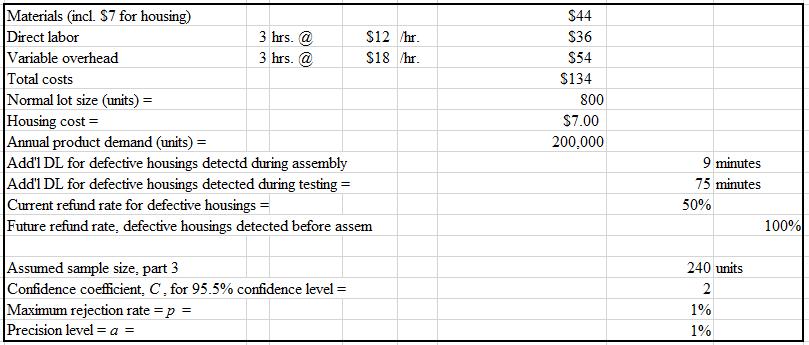Paragon Manufacturing produces small motors for assembly in handheld tools such as chain saws and circular saws.
Question:
Paragon Manufacturing produces small motors for assembly in handheld tools such as chain saws and circular saws. The company recently began manufacturing a new motor, model EZ3, and forecasts an annual demand of 200,000 units for this model.
Each model EZ3 requires a housing manufactured to precise engineering specifications. Paragon purchases these housings, which are not subject to quality control inspection before entering the production process; however, paragon performance-tests the entire motor after final assembly. During pilot production runs of the new motor, several of the housings had wrong sizes and were rejected.
If the housings were too shallow, they could not be assembled correctly; if they were too deep, the motor would not operate properly.
Ross Webster, Paragon’s production manager, gathered the following information during the pilot production runs. When housings were rejected during assembly because they were too shallow, they were replaced with new housings. This change in housings required nine minutes of additional direct labor for each affected unit. The units that were rejected during performance testing because the housings were too deep had to be torn down and reassembled with new housings. This operation required 1 hour and 15 minutes of additional direct labor for each affected unit.
The supplier of the housings is willing to take back the defective housings but will refund only one-half of the price. In the future, if Paragon inspects the housings before they enter the assembly process, the supplier will refund the full price of all rejected housings. The costs of model EZ3 follow:

The majority of the rejections experienced during the pilot runs were related to the housings. Ross's estimate of the probability of rejections for a lot of 800 housings follows:

If Paragon decides to inspect the housings prior to assembly, Ross must select the appropriate sample size by using the following two formulas. The estimated sample size (formula 1) must be modified by the second formula (final sample size) because Ross will be sampling without replacement.

Where:
nc = first estimate of sample size
nf = final sample size
C = confidence coefficient
p = maximum rejection rate
q = 1 – p
a = precision level
N = number of items in the population
Required
1. Determine the maximum amount that Paragon Manufacturing would be willing to spend annually to implement quality control inspection of the housings before assembly begins. (Check figure: $509,000.)
2. For the purpose of quality control inspection, determine the sample size that Ross should select from a lot of 800 housings if the desired level is 95.5 percent (confidence coefficient 2.00) with a precision of 1 percent and rejections not to exceed 1 percent. (Check figure: 265 Units.)
3. Without prejudice to your answer in requirement 2, for quality control inspection purposes, assume that the sample size is 240 housings and the desired level is 95.5 percent (confidence coefficient 2.00) with a precision of 1 percent and rejections not to exceed 1 percent.
4. Determine whether Ross should accept or reject a lot if there are:
a. Two defective housings in the sample.
b. Three defective housings in the sample. Explain your answer in each situation.
Step by Step Answer:

Cost management a strategic approach
ISBN: 978-0073526942
5th edition
Authors: Edward J. Blocher, David E. Stout, Gary Cokins





